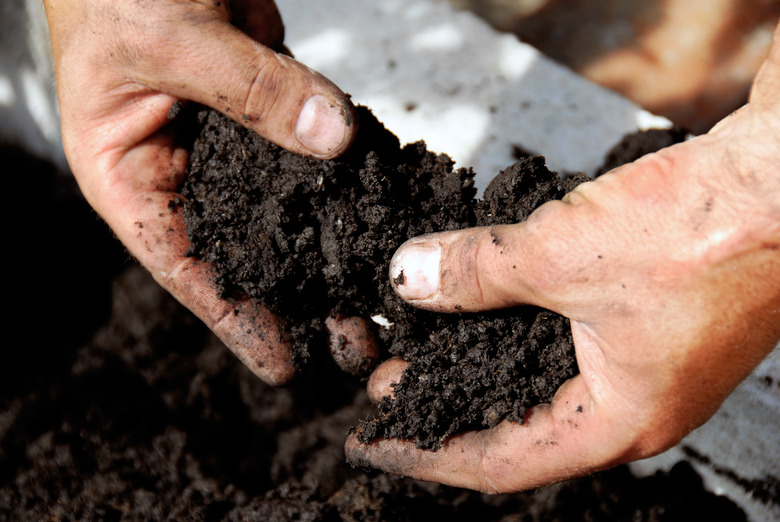What Is An Acid Fertilizer?
Fertilizers that help provide plants with nutrients normally available in acidic soil are often called acid fertilizers. When soil pH levels drop into the acidic range, below the neutral point of 7.0, certain nutrients become more available to plants. Some acid fertilizers lower soil pH to free up these existing nutrients. Others directly provide the nutrients that become restricted at higher, non-acid soil pH.
Why Acid Fertilizers Are Used
Why Acid Fertilizers Are Used
Plants rely on soil to provide essential nutrients for plant growth. These nutrients must be in soluble forms that plants can absorb. At different pH levels, chemical elements interact and bond other elements, making them unavailable to plants. For example, iron becomes less available in non-acidic soil. Some plants such pin oak (Quercus palustris), hardy in U.S. Department of Agriculture plant hardiness zones 4 through 8, require abundant iron for health. High-pH, or alkaline, soil leads to iron deficiency, poor health and yellow, chlorotic leaves — even when soil contains plentiful iron. By adding pH-lowering fertilizers to the soil, iron and similar nutrients become available in greater quantity.
Acid Fertilizer for Long-Term Change
Acid Fertilizer for Long-Term Change
Sulfur fertilizer lowers soil pH for long-lasting increases in acidity, but these changes takes time. Elemental sulfur lowers pH as soil bacteria covert it to sulfuric acid. The long-term process may take months, depending on weather, bacteria and current pH. A soil test confirms the amount of sulfur needed to reach acidic-pH goals. Rates vary depending on specific soil types and target pH. For example, lowering soil pH from 7.5 to 6.0 requires 0.2 pounds of elemental sulfur per 10 square feet in sandy soils. In clay, the same change takes more than twice as much. Follow soil test recommendations closely; pH extremes push some elements to levels toxic to plants.
Fast-Acting Acid Fertilizers
Fast-Acting Acid Fertilizers
Sulfur combined with other elements provides faster, less-enduring pH fixes. For example, aluminum sulfate quickly lowers soil pH as aluminum and sulfur react in moist soil. Acid-available aluminum isn't an essential nutrient, but it still affects plants. Bigleaf hydrangea (Hydrangea macrophylla), hardy in USDA zones 4 through 11, depends on this element for blue blooms. Aluminum sulfate frees up soil aluminum by lowering pH and adds extra aluminum. Rely on soil testing for fast-acting acid fertilizers recommendations and repeat intervals. Lowering pH from 7.5 to 6.0 with aluminum sulfate requires 1.4 pounds per 10 square feet in sandy soil, but over 3 pounds in clay. In soil with high amounts of aluminum, different fertilizers may be recommended so aluminum doesn't reach toxic levels.
Fertilizers That Provide Acid-Available Nutrients
Fertilizers That Provide Acid-Available Nutrients
Liquid fertilizers marketed for "acid-loving" plants provide minor, temporary drops in soil pH while delivering nutrients rendered unavailable in high-pH soils. Applications must be made every two weeks to maintain the effects. Nutrients such as iron are provided in chelated forms, which keep them available to plants in non-acidic soil. One tablespoon of water-soluble, 30-10-10 acid fertilizer mixed with 1 gallon of water provides chelated micronutrients, independent of soil pH, when applied to foliage or to soil. Always wear gloves and safety goggles when working with any fertilizers or garden chemicals, and avoid contact with exposed skin. Wash thoroughly with soap and water after use.
References
- Clemson Cooperative Extension: Changing the pH of Your Soil
- University of Illinois Extension: Understanding Acid-Loving Plants and Soil pH
- University of Illinois Extension: How to Lower Soil pH
- University of Minnesota Extension: Modifying Soil pH
- University of Florida IFAS Extension: Understanding and Applying Chelated Fertilizers Effectively Based on Soil pH
- Missouri Botanical Garden: Quercus Palustris
- Missouri Botanical Garden: Hydrangea Macrophylla
- UMassAmherst Center for Agriculture, Food and the Environment: Nutrient Management for Ornamentals
